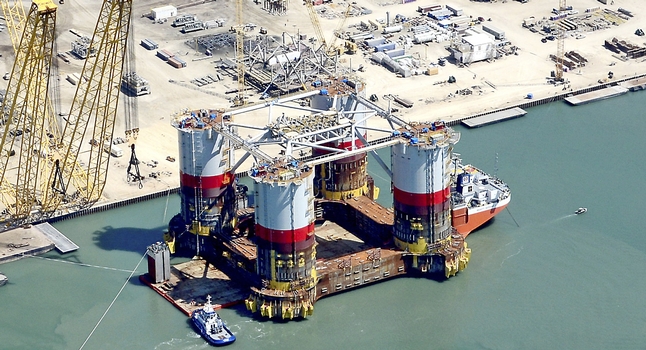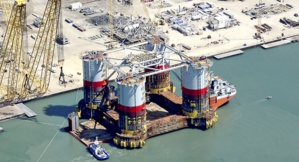Chevron Corp, Northern America’s second largest oil company, has been at the receiving end of an onslaught of bad news. Chevron had plans to start operations on its flagship oil project by the end of the year.
The Big Foot deepwater oil project off the New Mexico Gulf was meant to be a specialty oil rig, designed to pump up Chevron Corp’s daily output.
The Big Foot oil field floating platform was engineered to be set up in water about 5,200 feet deep and at a distance of about 225 miles south of the New Orleans coast.
On completion, the project was meant to come online by the end of this year, producing about 75,000 barrels of oil and 25m cubic feet of gas per day. Concerns, regarding the completion of the project, have escalated.
Chevron has been forced to suspend development on the project, to assess damages. This is the second series of equipment failure that has stopped work on the project.
In the past week, six of the sixteen intended tendons, meant to fasten a floating platform at the Big Foot oil field, were lost. And now in this week, three more connectors have sunk, further delaying the project.
The U.S oil company has issued a statement mentioning that a total of nine connectors have been lost. The tendons that appear like a long series of interlocking metallic pipes, and secure platforms to sea beds, sunk to the sea beds after failing to float.
Chevron has reported, no oil has leaked at site and all the employees are safe. The oil field’s initial startup plan for 2015 has now been scrapped, with the timeline indefinitely pushed back.
The 450 feet tall production platform was engineered to be secured with sixteen mile-long steel pipe tendons. The tendons are a series of interlocking pipes, ranging in diameters from 24 to 32 inches (around 61 to 81 centimeters), designed to be buoyant. They were supposed to hold their positions till the Big Foot platform was moved atop then and connected. Four tendons were engineered to link to each of the platform’s corners.
The conditions of the sunken connectors are still unknown. It is unclear that on retrieval, if they can be salvaged or new ones need to be built to replace them. According to the company spokesperson, Chevron has employed Remote-operated vehicle (ROV) robots, fitted with cameras to assess the situation of the connectors, as the water is too deep for divers. Four ROVs have been deployed besides 13 ships for access.
The Big Foot platform is now being shifted away from site, in order to safeguard it against damages. The two developments well dug at the Big Foot oil field couldn’t be connected to the platform either. The setback is going to affect Chevron in terms of production, cash flow to the project and loss in overall confidence in terms of operational quality.
Chevron, U.S’s 2nd largest oil producer, plans to release an update on the project’s timeline during its July earnings conference call.
References:
http://www.businessinsider.com/r-three-more-tendons-sink-at-chevrons-big-foot-site-in-us-gulf--2015-6
The Big Foot deepwater oil project off the New Mexico Gulf was meant to be a specialty oil rig, designed to pump up Chevron Corp’s daily output.
The Big Foot oil field floating platform was engineered to be set up in water about 5,200 feet deep and at a distance of about 225 miles south of the New Orleans coast.
On completion, the project was meant to come online by the end of this year, producing about 75,000 barrels of oil and 25m cubic feet of gas per day. Concerns, regarding the completion of the project, have escalated.
Chevron has been forced to suspend development on the project, to assess damages. This is the second series of equipment failure that has stopped work on the project.
In the past week, six of the sixteen intended tendons, meant to fasten a floating platform at the Big Foot oil field, were lost. And now in this week, three more connectors have sunk, further delaying the project.
The U.S oil company has issued a statement mentioning that a total of nine connectors have been lost. The tendons that appear like a long series of interlocking metallic pipes, and secure platforms to sea beds, sunk to the sea beds after failing to float.
Chevron has reported, no oil has leaked at site and all the employees are safe. The oil field’s initial startup plan for 2015 has now been scrapped, with the timeline indefinitely pushed back.
The 450 feet tall production platform was engineered to be secured with sixteen mile-long steel pipe tendons. The tendons are a series of interlocking pipes, ranging in diameters from 24 to 32 inches (around 61 to 81 centimeters), designed to be buoyant. They were supposed to hold their positions till the Big Foot platform was moved atop then and connected. Four tendons were engineered to link to each of the platform’s corners.
The conditions of the sunken connectors are still unknown. It is unclear that on retrieval, if they can be salvaged or new ones need to be built to replace them. According to the company spokesperson, Chevron has employed Remote-operated vehicle (ROV) robots, fitted with cameras to assess the situation of the connectors, as the water is too deep for divers. Four ROVs have been deployed besides 13 ships for access.
The Big Foot platform is now being shifted away from site, in order to safeguard it against damages. The two developments well dug at the Big Foot oil field couldn’t be connected to the platform either. The setback is going to affect Chevron in terms of production, cash flow to the project and loss in overall confidence in terms of operational quality.
Chevron, U.S’s 2nd largest oil producer, plans to release an update on the project’s timeline during its July earnings conference call.
References:
http://www.businessinsider.com/r-three-more-tendons-sink-at-chevrons-big-foot-site-in-us-gulf--2015-6






